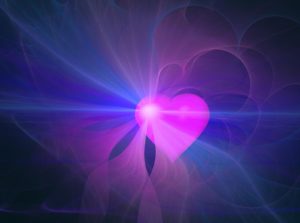
The soul in the heart: The address. Credit: Ute Possega-Rudel
Yesterday I found my stash of Paramahansa Yogananda Self-Realization Fellowship (SRF) monthly lessons from decades ago.
I now have access again to the documents which are the source of the equation of “Om” with the “Holy Spirit.”
Each of these fundamental statements is of immense value to the spiritual student. To me, they’re like a child finding a gold coin on the street. (1)
In poring over the documents, I came across this passage which sent me off in an entirely different direction and it’s really this that I’d like to talk about here.
Yogananda said:
“As a soul, man can never find true satisfaction merely through possessions and selfish interests.” (2)
Wonderful benchmarks. I think they’re open to misunderstanding. Let me depart from the usual interpretations in looking at them.
The “soul” is the operator inside the body, operating all the levers. Anyone who has had a lucid out-of-body experience has experienced the soul as being separate from the body.
Souls can never find true satisfaction through objects and selfish interests.
True satisfaction he defines as “eternal, ever-new Bliss, and along with it … Immortality [Ascension], and everlasting consciousness.” (3)
If we lived in the Blissful state Yogananda refers to, which is a state of at least the Fifth Dimension, we would already be what he calls “immortal.”
Immortal as he’s using it simply means that we exist in a Fifth-Dimensional consciousness state or higher. We now no longer need to be born and die. This is moksha or liberation.
But in point of fact we always were, are, and will be immortal, no matter what dimension we’re in. The soul never dies.
Yogananda adds to bliss the modifier “everlasting.” That also is significant because Ascension is the first state of consciousness in which this degree of bliss or love is permanently felt.
Even though my experience of it in 2015 went on for months, it still proved to be only a glimpse. Meanwhile, Ascension is permanent.
Experiencing bliss forever…. Hmmm…. That sure sounds like Ascension to me. (4) But his readership would not have known what he was talking about if he used that term in the 1940s. (5) So this may be the way he goes about it. That in itself is a fascinating study (when I retire).
But why does he emphasize possessions and selfish interests?
In answering, let me focus on love, just because I think that more people identify with it than bliss.
First, love is very much an inward affair. Although it’s everywhere, each individual is able to experience it in the heart more sensibly than anywhere else.
Therefore Yogananda advises against seeking it in external objects or concrete possessions. That isn’t the way life was designed. We’re to seek it in our own hearts.
Second, Love and Bliss must flow. They cannot, as far as I’m aware, remain still. To a limited extent, we can circulate them around us but because of the substantiality of the flow (a tsunami), love really needs a bigger target, so to speak … like the world.
“Universal love” is a partial repetition of terms (a pleonasm) because love is already universal. If one has been in the flow for any length of time, one has seen and felt love’s motion. And its motion is a universal outward flow.
Moreover, love cannot be prevented from flowing in a certain direction. When control is exerted, at that point love disappears. It will not do other than flow; it cannot be forced or contained.
Third, the selfish impulse is a dam in the way of the tsunami of love. Selfishness,where our caring is inward-turned, prevents the experience of higher-dimensional love because it goes against the outward flow of love. It acts like a barrier.
Trying to restrict all enjoyment to just our own won’t produce the conditions under which we’d experience the kind of higher-dimensional love that I’m pointing at.
But experiencing it, Yogananda says, is the highest goal of humanity. And I totally agree with that statement. I’d add that deepening into it is the highest business of humanity.
I haven’t experienced the depth of love that Yogananda did. But I’ve experienced the same kind of love. I now know the address (the heart).
Where Yogananda is is far down the road from where I am. But I now know the way. Theoretically, all I need do now is cover the distance. (5)
Footnotes
(1) Yogananda’s statement was important for me for many years – even decades – providing the one link I had between the universal creative vibration that Om is and the Holy Spirit, which I’d already connected to the Divine Mother.
You could say, “Why not use Yogananda to get enlightened rather than to make spiritual equations?”
I’m repeating myself: This is a lifetime of service, not of seeking personal enlightenment. Although that is sure to come as well because service is itself a path to God, it isn’t what I signed on for: I’m a lightworker.
(2) Self-Realization Fellowship Lesson S-5 P-114, p. 6.
(3) Ibid., 5.
(4) Yogananda may have been indicating Ascension when he spoke of “the final state of unbroken oneness with God’s consciousness everywhere – nirbikalpa samadhi.”
“Nirbikalpa samadhi” is an incomplete statement. If it was “kevalya nirvikalpa samadhi,” that would be seventh-chakra enlightenment or Brahmajnana. That’s not Ascension. That’s halfway up the mountain.
Ascension is “sahaja nirvikalpa samadhi.” “Sahaja” means natural. It’s at least possible that Yogananda was pointing at Ascension. It would have been a rarely-attained state in those days. I only know for sure that, apart from the avatars, Ramana Maharashi attained it. It’s what we’re gradually preparing for as a planet.
(5) That didn’t stop him from inventing words when he needed to, such as “lifetrons.”
(6) But as a pillar, I’m here to the end so no early Ascension for me. Nevertheless, you gatekeepers….???

